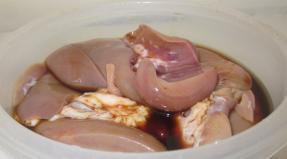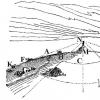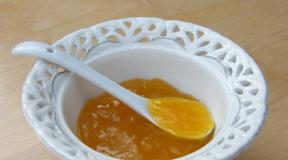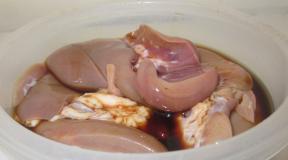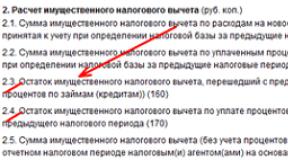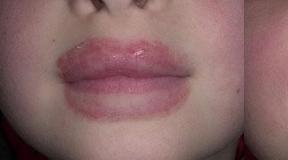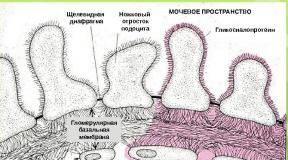The use of uralit-u in the fight against urolithiasis. Medicinal reference book geotar How to prevent urolithiasis
Instructions for use:
Uralit-U is a drug for the treatment of nephrolithiasis; it has an alkalizing effect on urine.
Release form and composition
Dosage form - granules for the preparation of a solution for oral administration: light orange, fine-grained mass with a specific odor (280 g in a polypropylene container, 1 container in a cardboard box, complete with a measuring spoon, indicator paper, clip, control calendar).
2.5 g (1 scoop) of granules contains:
- active ingredient: potassium sodium hydrogen citrate – 2.4277 g, which corresponds to a ratio of 6:6:3:5 hexakalium-hexanatrium-trihydrogen-pentacytrate;
- auxiliary components: lemon oil, sunset dye (E 110), hydration water of the active substance.
Indications for use
- prevention and treatment of nephrourolithiasis: cystinuria, uric acid stones, cystine stones, uraturia;
- the need to alkalize urine in cases of porphyria tarda, gout, and treatment with cytostatics.
Contraindications
- hereditary episodic adynamia;
- renal failure in acute and chronic forms;
- metabolic alkalosis;
- chronic urinary tract infections caused by bacteria that break down urea;
- low salt diet;
- poorly controlled diabetes mellitus or adrenal insufficiency in patients with urine acidity above 7;
- acute dehydration;
- age up to 12 years;
- individual intolerance to the components of the drug.
Caution should be exercised when prescribing Uralit-U for severe liver dysfunction.
Directions for use and dosage
The ready-to-use solution is intended for oral administration after meals.
To dissolve 1 measuring spoon, 250 ml of water is required; the resulting liquid has a light orange transparent structure with a specific odor.
The dose of the drug depends on the acidity of fresh urine, therefore, before directly taking the granules, it is necessary to moisten the indicator paper strip in the urine. For convenience, the indicator strip can be held with a special clip. The color of the wet strip is compared to a color chart and the acidity (pH) of the urine is determined. The control calendar indicates the pH and the dose of Uralit-U taken.
The control calendar should be with the patient at every visit to the doctor.
- Fresh urine pH 6.2–6.8: 4 scoops (10 g) per day, divided into three doses: 1 scoop in the morning and afternoon and 2 scoops in the evening;
- The pH of fresh urine is less than 6.2: 4.5 scoops per day, of which take 1 scoop in the morning and afternoon and 2.5 scoops in the evening;
- The pH of fresh urine is above 6.8: 3.5 scoops per day, of which 1 scoop is taken in the morning and afternoon and 1.5 scoops in the evening.
The dose is considered correctly selected if the pH of fresh urine is within the recommended range (6.2–6.8).
The daily dose for preventing the formation of calcium-containing kidney stones is 2-3 scoops per day, taken once in the evening. If the pH value of the urine is too low, the dose is increased to 3–4.5 scoops and divided into 2–3 doses during the day; It is recommended to maintain the pH of fresh urine in the range of 6.2–7.4.
Side effects
When taking Uralit-U, undesirable effects more often occur in the form of moderate abdominal pain, nausea, and diarrhea.
In case of overdose in patients with urine pH above 7, the development of phosphate nephrourolithiasis is possible.
special instructions
During the period of use of the drug, you must follow a diet and drink plenty of fluids.
Since the formation of kidney stones may be influenced by some concomitant diseases or specific therapy for parathyroid adenoma, malignant tumor and other pathologies, before starting the use of Uralit-U, the patient should be examined to exclude this effect. In addition, it is necessary to check renal function, determine the level of electrolyte concentrations in the serum, and in patients with suspected renal tubular acidosis, examine the acid-base status.
Patients with individual intolerance to acetylsalicylic acid are at increased risk of developing allergic reactions, and in rare cases, sensitized individuals (including the development of bronchial asthma).
When using granules for porphyria cutanea tarda, the urine pH level should be 7.2–7.5.
When treating with cytostatics, urine is alkalized to prevent a significant increase in the level of uric acid concentration. The drug has a protective effect on the alkaline pH of urine, which helps reduce the aggressiveness of metabolites of isofosfamide derivatives (isophosphamide, cyclophosphamide) and increase the solubility of cytostatics (including methotrexate) and their metabolites. The urine acidity level should not be lower than 7.
Drug interactions
The simultaneous use of aldosterone antagonists, non-narcotic analgesics, angiotensin-converting enzyme inhibitors, potassium-sparing diuretics, non-steroidal anti-inflammatory drugs reduces the renal excretion of potassium (1 g of the drug contains 0.172 g of potassium).
Patients on a low-sodium diet should note that 10 g of the drug contains 2.6 g of sodium chloride.
When Uralit-U is combined with drugs containing aluminum, aluminum absorption increases, therefore, if it is necessary to use this combination, the interval between their doses should not be less than two hours.
Analogs
There is no information about analogues.
Terms and conditions of storage
Keep away from children.
Store at temperatures up to 25 °C.
Shelf life – 5 years.
Uralit-U- nephrolitholytic, alkalizing urine.
Dissolving and preventing the formation of uric acid stones. Regulates the pH of urine and maintains a shift in the reaction to the alkaline side for a long time to pH values of 6.2-7.5, at which uric acid salts are in solution and do not form stones.
It maintains for a long time a shift of the reaction towards the alkaline side, in which uric acid salts are in solution and do not form stones. The process is dose-dependent. Alkalosis reduces urinary calcium excretion. Presumably, citrate ions are an effective physiological inhibitor of calcium oxalate (and calcium phosphate) crystallization and aggregation of these crystals.
Indications for use
Indications for use of the drug Uralit-U are: uric acid stones (prevention and treatment), nephrourolithiasis and cystinuria (auxiliary therapy); alkalinization of urine in case of skin porphyria, uricosuria, treatment with cytostatics.Mode of application
Uralit-U taken orally, the granules are dissolved in a glass of water and drunk.Before each dose, the pH of the urine is measured, after which the dose is determined.
The average daily dose is 10 g (4 scoops), taken in the morning and afternoon - 1 scoop, in the evening - 2 scoops, taking into account the pH of fresh urine: for urolithiasis and uricosuria 6.2-6.8; for cystine stones - 7.5-8.5; when treated with cytostatics - at least 7, with porphyria - 7.2-7.5.
The correct dose ensures pH values within the specified range; at higher urine pH values, the daily dose in the evening should be reduced by 1/2 scoop; if the pH value is lower, increase the dose by 1/2 scoop.
Side effects
When using the drug Uralit-U no side effects were identified.Contraindications
Contraindications to the use of the drug Uralit-U are: acute and chronic renal failure, an absolute ban on the use of table salt, severe violations of acid-base balance (metabolic alkalosis), chronic urinary tract infections.Pregnancy
Clinical data on use Uralita-U not enough in pregnant women. Experimental studies on animals did not reveal any signs of teratogenic or embryotoxic effects of the drug. Since the active ingredient is a combination of substances normally present in the body, the drug can be used during pregnancy and lactation according to the indicated dosage recommendations. If it is necessary to use during pregnancy and lactation, the expected benefit for the mother should be weighed against the likely risk for the fetus and child.Interaction with other drugs
Any increase in extracellular potassium concentration will weaken the effect of cardiac glycosides, while any decrease will enhance the arrhythmogenic effect of cardiac glycosides. Aldosterone antagonists, potassium-sparing diuretics, ACE inhibitors, non-steroidal anti-inflammatory drugs and non-narcotic analgesics reduce renal excretion of potassium. It should be remembered that 1.0 g of the drug contains 0.172 g or 4.4 mmol of potassium. When following a low-sodium diet, it must be taken into account that 1.0 g of Uralit-U contains 0.1 g or 4.4 mmol of sodium, which is equivalent to 0.26 g of sodium chloride. Preparations containing citrates, when taken simultaneously with drugs containing aluminum, may enhance the absorption of aluminum. If taking such drugs is necessary, the interval between doses of each of them should be at least 2 hours.Overdose
Symptoms of drug overdose Uralit-U: With normal renal function, there is no likelihood of undesirable effects on metabolic parameters even after taking doses higher than recommended, since the excretion of excess alkali by the kidneys is a natural regulatory mechanism that ensures acid-base status.Treatment: Accidental overdose can be eliminated at any time by reducing the dose; If necessary, consult a doctor; as a rule, appropriate measures are used to treat metabolic alkalosis.
Storage conditions
A drug Uralit-U should be stored in a dry place, in a well-closed container. Keep out of the reach of children.Release form
Uralit-U - granules.In jars of 280 g, in a box there is 1 jar complete with a measuring spoon, indicator paper, and a control calendar.
Compound
2.5 g granulate (1 scoop) Uralit-U for the preparation of a solution for oral administration, they contain hexacalium-hexanesodium-trihydrogen citrate complex (6:6:3:5) 2.4 g.Additionally
It is recommended to constantly monitor urine pH (for example, using special indicator paper with a pH range of 7.2-9.7).The simultaneous administration of digitalis preparations or a sodium-poor diet requires taking into account that the average daily dose contains approximately 1.75 g (44 mmol) of potassium and 1 g (44 mmol) of sodium.
Main settings
| Name: | URALIT-U |
| ATX code: | G04BC - |
Agents that help dissolve urinary stones.
How does Uralit-U work?
Salts of strong bases combined with weak acids alkalize (neutralize) the pH of the urine, and the acid component is metabolized. Excess base formed from alkali ions is excreted by the kidneys and increases the pH of the urine. The citrate ion from alkaline citrates undergoes oxidative metabolic breakdown to CO2 or bicarbonate. Citrate excretion increases, counteracting the formation of kidney stones.
Neutralization or alkalinization of urine can be achieved by oral administration of alkaline citrates; The response to the drug is dose-dependent.
1 g of potassium-sodium-hydrocitrate complex (8.8 mmol of alkali) increases the pH of urine by 0.2-0.3 units. As a result, the degree of dissociation and, consequently, the solubility of uric acid increases. Dissolution of uric acid stones was confirmed by x-ray.
Serum concentration of bicarbonate (negatively charged excess base) is a regulator of citrate excretion. Negatively charged excess base induces alkalosis by changing intracellular pH. Alkalosis suppresses the tubular metabolism of citrate in the kidneys, which leads to decreased absorption of citrate and increased excretion.
In addition, alkalosis affects excessive calcium excretion and reduces urinary calcium excretion.
These mechanisms, namely, alkalinization of urine, increase the excretion of citrate and reduce the excretion of calcium, which leads to a decrease in the activity of calcium oxalate, since citrate in a weak alkaline environment forms stable complexes with calcium (counteracting excessive saturation of lithogenic components).
After a one-day intake of potassium-sodium-hydrocitrate complex, an equivalent amount of sodium and potassium is excreted by the kidneys within 24-48 hours. During long-term use, the daily excretion of sodium and potassium is equal to the daily intake.
No significant changes in blood gases and serum electrolytes were observed. This indicates that due to renal regulation of alkalization, the acid-base balance of the body remains disturbed, and with normal renal function any possibility of accumulation of sodium or potassium can be excluded.
Indications
Dissolution of uric acid stones.
Prevention of the formation (prevention of relapses) of calcium-containing and uric acid stones, as well as mixed stones that contain calcium oxalate/uric acid or calcium oxalate/calcium phosphate.
Contraindications
- hypersensitivity to the components of the drug;
- acute or chronic renal failure;
- metabolic alkalosis;
- hereditary episodic adynamia;
- chronic urinary tract infections caused by bacteria that break down urea (risk of struvite stone formation);
- low salt diet;
- acute dehydration.
How to take Uralit-U
The granules should be dissolved in a glass of water and drunk.
To dissolve and prevent recurrence of uric acid stones: as a rule, take 4 scoops (= 10 g of granules, equivalent to 88 mmol of alkali) per day, divided into three doses, after meals. 1 measuring spoon is taken in the morning, 1 measuring spoon in the afternoon, and 2 measuring spoons in the evening, while the pH of fresh urine should be in the range of 6.2 - 6.8. If the pH value is below the recommended range, the daily dose should be increased by half a measuring spoon (11 mmol of alkali), adding it to the evening dose of the drug. If the pH value is above the recommended range, the daily dose should be reduced by half a scoop (11 mmol of alkali) by reducing the evening dose. The dose will be considered correctly selected when the pH of fresh urine before taking Uralit-U is within the recommended range.
To prevent the formation of uric acid stones, regular testing of urine pH is recommended.
To prevent the formation of calcium-containing kidney stones: the daily dose is 2 - 3 scoops (= 5 - 7.5 g granules, equivalent to 44 - 66 mmol alkali) once in the evening. If the pH value of the urine is too low, you should take 3 - 4.5 scoops (= 7.5 -11.25 g of granules, equivalent to 66 - 99 mmol of alkali) in 2-3 doses during the day after meals. An attempt should be made to maintain a urine pH of 7.0, but the pH should not fall below 6.2 or rise above 7.4. It is necessary to regularly monitor the concentration of citrates and/or urine pH and adjust the individual dose accordingly (see above).
Measuring urine pH: immediately before each dose of the drug, take the indicator paper strip that is in the package and, holding it with a clamp (also included), moisten it with fresh urine. The color of the wet strip is then compared to the color chart and the pH value printed below the corresponding color is noted. This pH value and the number of measuring spoons with granules taken are recorded in the control calendar. The patient should take the control calendar with him at each visit to the doctor.
Adverse reactions
The drug is usually well tolerated, but the following side effects may occur.
From the digestive tract: often - moderate pain in the stomach or abdomen, rarely - moderate diarrhea and nausea. Hyperkalemia may develop.
Sunset Yellow FCF (E 110) may cause allergic reactions including asthma in sensitive individuals.
Overdose
With normal renal function, there should be no adverse effect on metabolic parameters, even after taking doses much higher than recommended, since the elimination of any base by the kidneys triggers a natural regulatory mechanism that maintains the acid-base balance in the body.
Any increase in urine pH above the recommended range should never last longer than a few days, since very high pH levels increase the risk of phosphate crystallization and a state of metabolic alkalosis may occur, which is in any case undesirable. Unintentional overdose can be corrected at any time by reducing the dose; if necessary, appropriate measures should be taken to treat metabolic alkalosis.
Use during pregnancy or breastfeeding
There is insufficient data on the use of Uralit-B ® in pregnant women. Since the active substance is a combination of substances found in the body, the drug can be used during pregnancy and lactation in accordance with the specified dosage recommendations. There is no evidence of harmful effects during pregnancy and lactation.
Features of application
In all cases, the use of the drug should be part of the overall concept of treatment and prevention (diet, increased fluid intake, etc.). Before starting therapy, it is necessary to conduct examinations aimed at identifying all cases of concomitant diseases that contribute to the formation of kidney stones in order to exclude them. This also applies to cases of specific therapy (parathyroid adenoma, malignant tumors generating the formation of uric acid stones, etc.). Before the first dose, it is necessary to determine the concentration of electrolytes in the serum and check renal function. In addition, if renal tubular acidosis (RTA) is suspected, the acid-base status should be checked.
Uralit-U contains sunset dye (E 110), which in rare cases can cause allergic reactions, including bronchial asthma in sensitized individuals. Allergic reactions are more common in people with hypersensitivity to acetylsalicylic acid.
Treatment with cytostatics: During treatment with cytostatics, it is advisable to alkalize the urine in order to prevent an increase in the concentration of uric acid, which is consistent with measures to prevent the formation of uric acid stones. In addition, there is information about the protective effect of alkaline urine pH, which reduces the aggressiveness of cytostatic metabolites, such as isophosfamide derivatives (cyclophosphamide, isophosphamide) and increases the solubility of cytostatics (for example, methotrexate) and their metabolites. Urine pH values must be maintained at a level not lower than 7.0. In porphyria cutanea tarda there is a deficiency of uroporphyrinogen decarboxylase, under the influence of which uroporphyrinogen is metabolized into coproporphyrinogen. The purpose of metabolic alkalinization is to prevent re-diffusion of coproporphyrin through the renal tubules, which in turn increases the clearance of coproporphyrin.
It is believed that as a result of increased excretion of coproporphyrinogen, there is an increase in the synthesis of coproporphyrinogen from uroporphyrinogen and, as a consequence, there is a decrease in the amount of circulating uroporphyrin. The urine pH value should be 7.2 - 7.5.
Uralit-U does not affect or may slightly affect the ability to drive vehicles or other machinery.
Interaction with other drugs
Any increase in extracellular potassium concentration will attenuate the effect of cardiac glycosides, whereas any decrease will enhance the arrhythmic effect of cardiac glycosides. Aldosterone antagonists, potassium-sparing diuretics, ACE inhibitors, non-steroidal anti-inflammatory drugs and peripheral analgesics reduce renal excretion of potassium. It should be remembered that 1 g of Uralit-V ® contains 0.172 g or 4.4 mmol of potassium.
When following a low-sodium diet, remember that 1 g of Uralit-B ® contains 0.1 g or 4.4 mmol of sodium, which is equivalent to 0.26 g of sodium chloride.
Drugs containing citrates and taken at the same time as drugs containing aluminum may enhance the absorption of aluminum, so if such drugs are prescribed, the interval between doses of each of them should be at least 2:00.
Storage conditions
Store in a tightly sealed container at a temperature not exceeding 25° out of the reach of children. Shelf life: 5 years.
Uralit-U is a drug that is used to dissolve urinary stones and prevent their formation. Available in the form of granules for the preparation of a solution for oral use.
Pharmacological action of Uralit-U
According to the instructions for Uralit-U, the active ingredient of the drug is potassium sodium hydrogen citrate. The auxiliary substances included in the granules are lemon oil, dye, and purified water.
Uralit-U is a mixture of weak acids and salts of strong alkalis.
When they get into water, they dissolve and dissociate (break up) into ions, which helps maintain the alkaline reaction of urine for a long time and set the pH level within 6.2-7.5. With such acidity of urine, its salts remain in a dissolved state, thereby preventing the formation of stones. This process is due to the nephrolytic property of the drug. The patient's reaction to Uralit-U is dose-dependent.
The active ingredient of the drug blunts the reabsorption of citrate in the renal tubules and accelerates its excretion.
When taken orally, Uralit-U is completely and quickly absorbed from the gastrointestinal tract. It has high bioavailability and does not change the gas composition of blood plasma electrolytes. Excreted from the body through the kidneys.
Indications for use Uralit-U
Uralit-U is prescribed to prevent the formation and to activate the process of dissolution of existing calcium-containing and uric acid stones in case of urolithiasis, as well as stones in the bladder.
In case of late skin porphyria and uricosuria, the medicine alkalinizes the urine, which is due to its pathogenetic properties.
Methods of using Uralit U and dosage
Uralit-U granules are taken orally in the form of a solution, for the preparation of which the substance is dissolved in a glass of water.
To prevent and eliminate uric acid stones, take 4 scoops of granules per day, divided into 3 doses (1 scoop in the morning and afternoon, 2 in the evening). In this case, the pH level of fresh urine should be 6.2-6.8. If the value is below the recommended range, the evening dosage is increased by 1/2 scoop; if higher, the evening dosage is reduced by 1/2 scoop. If the dosage is correctly selected, the pH of fresh urine before taking the medicine will be within normal limits. To prevent the formation of uric acid stones, regular checking of the acidity level of urine is necessary.
In order to prevent the occurrence of calcium-containing stones, take 2-3 scoops of Uralit-U per day in one dose, preferably in the evening. When urine pH is low, take 3-4.5 scoops of granules, divided into 2-3 doses per day after meals. It is necessary to maintain urine acidity at 7.0 so that it does not fall below 6.2 and does not rise above 7.4. It is recommended to monitor the concentration of citrates and urine pH to adjust the individual dose of the drug accordingly.
Before each use of Uralit-U, you need to determine the reaction of fresh urine using special indicator strips. To do this, they are moistened with urine and after 2 minutes they are compared with the color scale. The test results and dosage of the drug are recorded in a control calendar, which is provided to the attending physician.
Side effects of Uralit-U
According to reviews of Uralit-U, the drug is well tolerated by patients. Rarely, adverse reactions from the gastrointestinal tract may occur, such as nausea, vomiting, abdominal pain, flatulence, diarrhea, which disappear on their own and do not require treatment or discontinuation of the drug.
Contraindications to the use of Uralit-U
Contraindications to Uralit-U, according to the instructions, are:
- Acute or chronic renal failure;
- Severe acid-base imbalance (metabolic alkalosis);
- Episodic adynamia of a hereditary nature;
- Chronic infectious diseases of the urinary tract, which are caused by urea-splitting bacteria;
- The need to follow a strict diet with limited salt intake;
- Children under 12 years of age;
- Hypersensitivity to the components of the drug.
Overdose
Reviews of Uralit-U report that with normal kidney function, an overdose of the drug is unlikely.
Analogues of Uralit-U
In terms of therapeutic action and chemical composition, analogues of Uralit-U are Cyston, Cital, Uro-Gran, Rendesmol, Fitolit, Fitolysin Plus.
Additional Information
The instructions for Uralit-U indicate that the medicine should be stored in a dark, dry place inaccessible to children.
Dispensed from pharmacies with a doctor's prescription.
Shelf life – 5 years.
Urolithiasis, or urolithiasis, is a disease that is manifested by the formation of stones or sand in the organs of the urinary system. This is a rather serious pathology that requires immediate treatment.
In severe forms, this disease requires surgical intervention. To avoid this, in the early stages of the disease, doctors recommend taking Uralit U. Instructions for use of this medicine, its features, release form and contraindications will be presented in this article.
Packaging, form, composition
The drug "Uralit" is produced in the form of granules. It is intended for the preparation of an oral solution.
This medication contains hexacalium-hexasodium-trihydrogen citrate complex. It is produced in a cardboard box, which contains one jar of the medicinal substance, as well as a measuring spoon, indicator paper and a control calendar.
Mechanism of action of the drug
What is a granulate like “Uralit-U”? The instructions for use inform that this medication is used to prevent the formation and dissolution of existing urinary stones.
The product in question is a mixture of strong alkalis (salts) that are combined with acids (weaker).

When mixed with ordinary water, the granulate dissociates into ions, maintains the alkaline reaction of urine for a long time, and also regulates the pH (at the level of 6.2-7.5).
This acidity allows uric acid salts to remain dissolved and not form stones. This is where the nephrolytic properties of this remedy manifest themselves.
Pharmacokinetics
According to expert reviews, the patient’s reaction to the medication in question is dose-dependent. Alkalosis reduces the absorption of citrate in the renal tubules and also increases its excretion. It should also be noted that in this case the excretion of calcium in the urine decreases.
The drug "Uralit" is almost completely absorbed from the digestive tract. Its bioavailability is about 100%. The entire drug is metabolized in the human body and excreted in the urine.
During therapy with this drug, no changes in the gas or electrolyte composition of the blood occur.
Indications for use
Do you know about the indications for which the drug “Uralit U” can be prescribed? Reviews from experts say that this drug should be taken for the treatment of certain diseases only after consultation with a urologist.

According to the instructions, the drug in question is used to prevent the formation, as well as to dissolve existing calcium-containing and uric acid stones in case of urolithiasis, including the presence of stones in the bladder.
In case of late porphyria and uricosuria, this medication has a pathogenetic effect and alkalinizes the urine.
As a rule, this medicine is included in therapy with cytostatic drugs in order to prevent possible complications.
Contraindications for use
What diseases prevent the use of Uralit-U granulate? The instructions for use state that this medication should under no circumstances be prescribed for chronic or acute renal or heart failure. In addition, the drug is not used for chronic urinary tract infections caused by microorganisms that break down urea; with severe metabolic alkalosis, confirmed in laboratory conditions, and intolerance to the components of the drug.
It should also be noted that Uralit-U granules are not prescribed if the patient needs to adhere to a strict salt-free diet (for example, with hypertension or kidney disease).

It should also be noted that the safety of the drug in question and its effectiveness have not been studied in children under 12 years of age, as well as in nursing mothers and pregnant women. In this regard, this medication is not prescribed to them.
The drug "Uralit-U": instructions for use
Before using the drug in question for the treatment of urolithiasis, it should first be dissolved in a glass of plain water.
The dosage of this medication is selected individually, depending on the reaction of fresh urine. It is determined using indicator papers, which are placed together with the medicine in a cardboard box. This process is carried out before each intake of granulate. To do this, the indicator is soaked in urine and compared with a color scale for two minutes. This will allow you to determine the acidity in the range of 5.4-7.4.
When treating porphyria tarda and cystine stones, it is necessary to use a special indicator with a pH range of 7.2-9.7.
The average dosage of this drug is 4 per day. In this case, you should drink one in the morning, one in the afternoon and two in the evening.
It is extremely important to maintain acidity levels within the required range:

If the norms obtained are higher, the dosage is reduced. The evening dose of the drug is reduced by ½ dosage spoon.
If the pH is lower, then the amount of medication is increased by the same volume.
Drug interactions
Is it allowed to combine Uralit-U granulate with other medications? Reviews from experts report that this remedy cannot be combined with all drugs.
According to the instructions, Uralit-U in combination with aluminum-containing drugs can enhance the absorption of aluminum ions into the blood. In this case, the interval between taking them should be at least two hours.
The course of therapy with this drug can be long-term, without breaks or with them. The average duration of taking this drug is 1-6 months. However, only a doctor should determine a more precise course of treatment.
Side effects
Now you know how to take Uralit-U. According to patient reviews, this drug is tolerated quite well. Although in rare cases, taking the oral solution may cause nausea, flatulence, vomiting, abdominal pain and diarrhea.

Typically, such adverse reactions go away on their own.
Medicine "Uralit-U": analogues and patient reviews
What can replace the drug in question? In terms of chemical composition and therapeutic effect, analogues of this product are: “Fitolysin Plus”, “Cyston”, “Fitolit”, “Cital”, “Rendesmol”, “Uro-Gran”.
According to reviews, Uralit-U is a highly effective drug that copes with the task quite well. Many patients report that after a month of treatment, stones are completely eliminated from the patient’s body. However, it should be noted that this process is often accompanied by a laxative effect, which brings significant discomfort to the patient.
Read also...
- Why do you dream about a man’s back?
- Fortune telling with hearts online: a simple and free way to tell fortunes about a guy’s love
- Dream Interpretation: flying above the ground in a dream
- Description of orange zest with photo, its calorie content; how to make at home; use of the product in cooking; harm and beneficial properties

